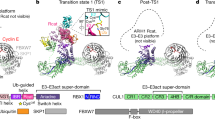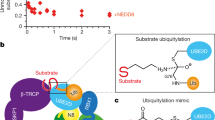Abstract
The concentrations and functions of many cellular proteins are regulated by the ubiquitin pathway. Cullin family proteins bind with the RING-finger protein Roc1 to recruit the ubiquitin-conjugating enzyme (E2) to the ubiquitin ligase complex (E3). Cul1 and Cul7, but not other cullins, bind to an adaptor protein, Skp1. Cul1 associates with one of many F-box proteins through Skp1 to assemble various SCF–Roc1 E3 ligases that each selectively ubiquitinate one or more specific substrates. Here, we show that Cul3, but not other cullins, binds directly to multiple BTB domains through a conserved amino-terminal domain. In vitro, Cul3 promoted ubiquitination of Caenorhabditis elegans MEI-1, a katanin-like protein whose degradation requires the function of both Cul3 and BTB protein MEL-26. We suggest that in vivo there exists a potentially large number of BCR3 (BTB–Cul3–Roc1) E3 ubiquitin ligases.
This is a preview of subscription content, access via your institution
Access options
Subscribe to this journal
Receive 12 print issues and online access
$209.00 per year
only $17.42 per issue
Buy this article
- Purchase on Springer Link
- Instant access to full article PDF
Prices may be subject to local taxes which are calculated during checkout





Similar content being viewed by others
References
Hochstrasser, M. Ubiquitin-dependent protein degradation. Annu. Rev. Genet. 30, 405–439 (1996).
King, R.W., Deshaies, R.J., Peters, J.-M. & Kirschner, M.W. How proteolysis drives the cell cycle. Science 274, 1652–1659 (1996).
Hershko, A. & Ciechanover, A. The ubiquitin system. Annu. Rev. Biochem. 67, 425–79 (1998).
Zachariae, W. & Nasmyth, K. Whose end is destruction: cell division and the anaphase-promoting complex. Genes Dev. 13, 2039–2058 (1999).
Deshaies, R.J. SCF and cullin/RING H2-based ubiquitin ligases. Annu. Rev. Cell Dev.Biol. 15, 435–467 (1999).
Pickart, C.M. Mechanisms underlying ubiquitination. Annu. Rev. Biochem. 70, 503–533 (2001).
Zheng, N. et al. Structure of the Cul1–Rbx1–Skp1–F box Skp2 SCF ubiquitin ligase complex. Nature 416, 703–709 (2002).
Bai, C. et al. SKP1 connects cell cycle regulators to the ubiquitin proteolysis machinery through a novel motif, the F-box. Cell 86, 263–274 (1996).
Skowyra, D., Craig, K., Tyers, M., Elledge, S.J. & Harper, J.W. F-box proteins are receptors that recruit phosphorylated substrates to the SCF ubiquitin–ligase complex. Cell 91, 209–219 (1997).
Feldman, R.M.R., Correll, C.C., Kaplan, K.B. & Deshaies, R.J. A complex of Cdc4p, Skp1p, and Cdc53p/Cullin catalyzes ubiquitination of the phosphorylated CDK inhibitor Sic1p. Cell 91, 221–230 (1997).
Kipreos, E.T., Lander, L.E., Wing, J.P., He, W.-W. & Hedgecock, E.M. cul-1 is required for cell cycle exit in C. elegans and identifies a novel gene family. Cell 85, 829–839 (1996).
Pause, A. et al. The von Hippel-Lindau tumor-suppressor gene product forms a stable complex with human CUL-2, a member of the Cdc53 family of proteins. Proc. Natl Acad. Sci. USA 94, 2156–2161 (1997).
Lonergan, K.M. et al. Regulation o fhypoxia-inducible mRNAs by the von Hippel-Lindau tumor suppressor protein requires binding to complexes containing elongins B/C and Cul2. Mol. Cell Biol. 18, 732–741 (1998).
Maxwell, P.H. et al. The tumor suppressor protein VHL targets hypoxia-inducible factor for oxygen-dependent proteolysis. Nature 399, 271–275 (1999).
Lisztwan, J., Imbert, G., Wirbelauer, C., Gstaiger, M. & Krek, W. The von Hippel-Lindau tumor suppressor protein is a component of an E3 ubiquitin–protein ligase activity. Genes Dev. 13, 1822–1833 (1999).
Ohh, M. et al. Ubiquitination of hypoxia-inducible factor requires direct binding to the β-domain of the von Hippel-Lindau protein. Nature Cell Biol. 2, 423–427 (2000).
Furukawa, M., Ohta, T. & Xiong, Y. Activation of UBC5 ubiquitin-conjugating enzyme by the RING finger of ROC1 and assembly of active ubiquitin ligases by all cullins. J. Biol. Chem. 277, 15758–15765 (2002).
Michel, J.J. & Xiong, Y. Human CUL-1, but not other cullin family members, selectively interacts with SKP1 to form a complex with SKP2 and cyclin A. Cell Growth Differ. 9, 435–449 (1998).
Michel, J.J., McCarville, J.F. & Xiong, Y. A role for Saccharomyces cerevisiae CUL8 ubiquitin ligase in proper anaphase progression. J. Biol. Chem. 278, 22828–22837 (2003).
Dias, D.C., Dolios, G., Wang, R. & Pan, Z.Q. CUL7: A DOC domain-containing cullin selectively binds Skp1.Fbx29 to form an SCF-like complex. Proc. Natl Acad. Sci. USA 99, 16601–16606 (2002).
Godt, D., Couderc, J.L., Cramton, S.E. & Laski, F.A. Pattern formation in the limbs of Drosophila: bric a brac is expressed in both a gradient and a wave-like pattern and is required for specification and proper segmentation of the tarsus. Development 119, 799–812 (1993).
Zollman, S., Godt, D., Prive, G.G., Couderc, J.L. & Laski, F.A. The BTB domain, found primarily in zinc finger proteins, defines an evolutionarily conserved family that includes several developmentally regulated genes in Drosophila. Proc. Natl Acad. Sci. USA 91, 10717–10721 (1994).
Bardwell, V.J. & Treisman, R. The POZ domain: a conserved protein–protein interaction motif. Genes Dev. 8, 1664–1677 (1994).
Xue, F. & Cooley, L. kelch encodes a component of intercellular bridges in Drosophila egg chambers. Cell 72, 681–693 (1993).
Clark-Maguire, S. & Mains, P.E. Localization of the mei-1 gene product of Caenorhaditis elegans, a meiotic-specific spindle component. J. Cell Biol. 126, 199–209 (1994).
Srayko, M., Buster, D.W., Bazirgan, O.A., McNally, F.J. & Mains, P.E. MEI-1/MEI-2 katanin-like microtubule severing activity is required for Caenorhabditis elegans meiosis. Genes Dev. 14, 1072–1084 (2000).
Kurz, T. et al. Cytoskeletal regulation by the nedd8 ubiquitin-like protein modification pathway. Science 295, 1294–1298 (2002).
Pintard, L. et al. Neddylation and deneddylation of CUL-3 is required to target MEI-1/Katanin for degradation at the meiosis-to-mitosis transition in C. elegans. Curr. Biol. 13, 911–921 (2003).
Collins, T., Stone, J.R. & Williams, A.J. All in the family: the BTB/POZ, KRAB, and SCAN domains. Mol. Cell. Biol. 21, 3609–3615 (2001).
Ohta, T., Michel, J.J., Schottelius, A.J. & Xiong, Y. ROC1, a homolog of APC11, represents a family of cullin partners with an associated ubiquitin ligase activity. Mol. Cell 3, 535–541 (1999).
Furukawa, M., Yanping, Z., McCarville, J., Ohta, T. & Xiong, Y. The C-terminal sequence and ROC1 are required for efficient nuclear accumulation, NEDD8 modification, and ubiquitin ligase activity of CUL1. Mol. Cell. Biol. 20, 8185–8197 (2000).
Acknowledgements
We thank the Kazusa DNA Research Institute (Chiba, Japan) for providing KIAA EST clones, S. Ahmed for providing the C. elegans library, N. Zheng for providing Cul3 and Roc1 baculoviruses, and C. McCall, J. McCarville and other members of the Xiong lab for discussion throughout this work and critically reading the manuscript. Y. X. is supported in part by a US Department of Defense Career Development Award. This study is supported by a National Institutes of Health grant to Y.X.
Author information
Authors and Affiliations
Corresponding author
Ethics declarations
Competing interests
The authors declare no competing financial interests.
Supplementary information
Rights and permissions
About this article
Cite this article
Furukawa, M., He, Y., Borchers, C. et al. Targeting of protein ubiquitination by BTB–Cullin 3–Roc1 ubiquitin ligases. Nat Cell Biol 5, 1001–1007 (2003). https://doi.org/10.1038/ncb1056
Received:
Accepted:
Published:
Issue Date:
DOI: https://doi.org/10.1038/ncb1056
This article is cited by
-
Neuronal knockdown of Cullin3 as a Drosophila model of autism spectrum disorder
Scientific Reports (2024)
-
Targeting E3 ubiquitin ligases and their adaptors as a therapeutic strategy for metabolic diseases
Experimental & Molecular Medicine (2023)
-
A pan-cancer analysis of thioredoxin-interacting protein as an immunological and prognostic biomarker
Cancer Cell International (2022)
-
Restoration of Cullin3 gene expression enhances the improved effects of sonic hedgehog signaling activation for hypertension and attenuates the dysfunction of vascular smooth muscle cells
BioMedical Engineering OnLine (2022)
-
Structures and biological functions of zinc finger proteins and their roles in hepatocellular carcinoma
Biomarker Research (2022)



